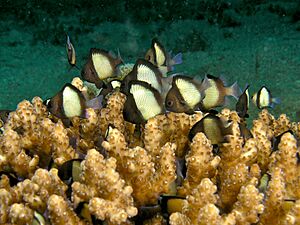Acropora loripes facts for kids
Quick facts for kids Acropora loripes |
|
|---|---|
 |
|
| Two stripe damselfish swimming among the branches of Acropora loripes | |
| Conservation status | |
| Scientific classification | |
| Synonyms | |
|
Acropora loripes is a type of coral that grows in branching shapes. It forms large groups, called colonies, made of many tiny animals. You can often find this stony coral on coral reefs in warm, tropical waters. It lives in the Indo-Pacific region, which includes the Red Sea and areas near Australia.
Contents
What Does Acropora loripes Look Like?
Acropora loripes is a branching coral, meaning it grows in shapes like tree branches. Its colonies can look very different. Some form large, round heads, while others grow in flat, plate-like layers. Sometimes, they even look like bottlebrushes!
The small branches, called branchlets, are about 5 to 12 millimeters (about 0.2 to 0.5 inches) wide. They can be up to 45 millimeters (about 1.8 inches) long. The very tips of these branches might be bare. Below the tips, you'll see tiny cup-shaped homes called corallites. The main ones are about 3 millimeters wide. Many larger, tube-shaped corallites are packed closely together, often touching each other.
Where Does Acropora loripes Live?
This coral is found in the tropical Indo-Pacific region. Its home stretches from the Red Sea all the way to countries like Thailand, Malaysia, Indonesia, and Papua New Guinea. It's also found near Australia, especially on the Great Barrier Reef.
Acropora loripes lives underwater, usually between 5 and 25 meters (about 16 to 82 feet) deep. It likes different parts of the reef, including the upper slopes and flat areas.
How Acropora loripes Lives
The hard part of Acropora loripes is its skeleton, which is made by tiny animals called polyps. This skeleton is covered by a thin layer of living tissue. When the polyps want to eat, they stick out from their little homes (corallites). Each polyp has twelve tiny arms, called tentacles, with one being longer than the others.
Inside the polyps, there's a body space that connects to other polyps. This connection happens through a network of channels. This coral also has special tiny plant-like helpers called dinoflagellates living inside its tissues. These helpers are like tiny plants that can make their own food using sunlight, a process called photosynthesis. They give the coral a lot of the energy it needs to live. These tiny helpers, along with colors in the coral's own tissue, give the colony its yellowish-brown color.
Reproduction and Life Cycle
Acropora loripes is a hermaphrodite, meaning each coral has both male and female parts. All the corals in an area often release their reproductive cells at the same time. This is a special event! On the Great Barrier Reef, adult corals release their cells into the sea about five or six days after the full moon in November and December.
When the cells are released, they meet and join together in the water. This is called external fertilization. After fertilization, tiny baby corals, called larvae, form. These larvae float around in the water as part of the plankton. Eventually, they settle down on the seabed. Once settled, they change and grow into new coral colonies.
Protecting Acropora loripes
Acropora loripes faces threats, but mostly from harm to the coral reefs where it lives. Like other corals in its group, it can suffer from coral bleaching, where it loses its color and can die. It's also affected by several coral diseases.
Another threat comes from the crown-of-thorns starfish. This starfish loves to eat the soft tissues and polyps of Acropora corals. Because of these threats to its home and itself, the IUCN Red List of Threatened Species lists Acropora loripes as "Near threatened". This means it could become endangered if things don't improve.


